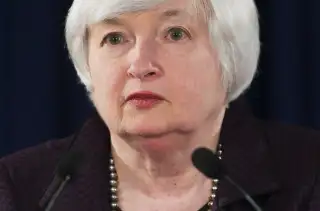The Fed Sees the Economy Getting Back to Normal. The Market’s Not So Sure.

The Federal Reserve has been signalling that it is getting ready to raise short-term interest from near-0% later this year. It recently ended its purchases of bonds under the unconventional stimulus program known as quantitative easing. Read the front-page newspaper headlines, and it looks like the era of very low interest rates is coming to an end.
But the numbers on the market tickers are telling a different story. This week the yield on safe 10-year Treasury bonds, a benchmark for long-term interest rates, tumbled to below 2%. What gives? How is it that interest rates are going down when it looks like the Fed wants to raise them?
The answer, in part, is simple. The Fed doesn't get to set interest rates on its own. Day-to-day market commentary make it sound like interest rates can be changed with the push of a button: Fed chair Janet Yellen and the rest of Federal Open Market Committee declare that rates shall rise, and then, boom, you get a better deal on CDs and have to pay more to refinance your house.
In fact, in normal times, the Fed only sets short-term rates. What happens to rates on loans maturing years down the road is determined by investors, and it all plays out in the moment-to-moment fluctuations of yields on the bond market. When demand for bonds is high, their prices go up and yields go down; yields rise when bond prices fall. Bond investors think a lot about Fed policy, but they also have their eyes on a host of other economic fundamentals that determine how much it should cost to borrow money.
"Fed policy matters a lot in the short term," Ben Inker, co-head of asset allocation at the mutual fund manager GMO, recently told me. "It only matters in the long-term if they show themselves to be incompetent."
Of course, these haven't been normal times. With the quantitative easing program, the Fed had also been buying up longer-term Treasuries. Lots of people believed that this meant yields were artificially low, and would spike once it looked like QE was over. But the end of the Fed's bond purchases hasn't led to a spike in rates. It turns out investors still really want to hold long-term government bonds. "I think now what people are saying is maybe rates weren't artificially low—maybe they were low for a reason," said Inker.
Investors like to hold Treasury bonds when they don't care for the alternatives, such as putting money into expanding their businesses or building new office buildings, houses, and factories. And they are happier to accept low rates when they don't see much risk of the economy overheating and producing inflation. In short, the low long-term yield on bonds reflects the market's fairly pessimistic outlook for growth in the long term.
The latest economic numbers from the U.S. are looking healthier lately. Unemployment has come down, and consumer confidence is up. Bond markets, however, are seeing a lot of bad news abroad, and perhaps are worrying that it will spill over to the U.S. In Europe, for example, very low inflation is threatening to turn into deflation—or falling prices—which may sound nice for consumers, but reflects weak demand and makes it harder for borrowers to settle their debts.
The weak global economy has also brought down yields on other government's bonds—Germany is paying 0.5%—which make Treasuries look like a comparatively good deal. That's another factor keeping demand for U.S. bonds high and yields low right now.
So here's the picture: The Fed sees an economy that's getting stronger, and is looking to raise short-term rates sometime this year to get ahead of the risk of inflation. But markets still see plenty to worry about. Those worries may include, as economist Brad Delong has pointed out, the risk that the Fed may slow down the recovery too soon.